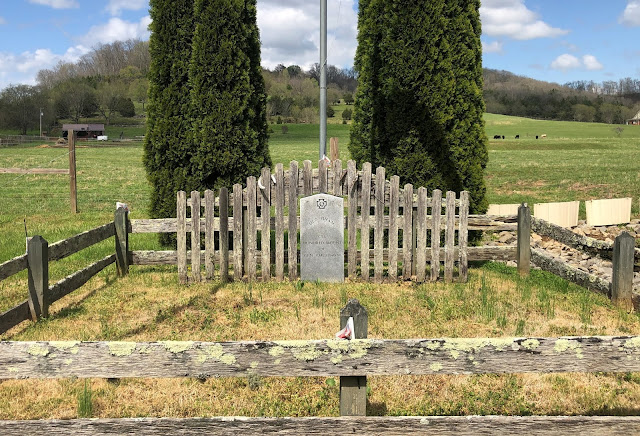 |
| The grave of Old Isham, Confederate General Frank Cheatham's horse. (Cheatham photo: Library of Congress) |
Like this blog on Facebook | Follow me on Twitter
WARNING! This post includes horse puns that may make you wince ... or worse. Some dialogue may be fabricated. Kernels of history, however, are included.
Confession: I recently became obsessed with the ties between Civil War horses and their riders.
“So stop horsin’ around then,” my wife told me, evidently reading my mind. “I don’t want to be a nag, but you really need to get out of the house, drive into the middle of nowhere, and visit the grave of Old Isham, the wartime horse of Frank Cheatham, the hard-drinking Confederate general who was no friend of the incompetent Braxton Bragg. Besides, I have a friend coming over.”
 |
| Your tour guide at the grave of Old Isham in rural Coffee County, Tenn. |
Feeling my oats, I reached speeds as high as 55 mph on Interstate 24 East, zooming past the exit for Stones River battlefield in overdeveloped Murfreesboro and three or four or 25 Cracker Barrel restaurants. At the Beechgrove/Bell Buckle exit, I debated whether to go left or right.
Go right and I could visit the area where British military observer Sir Arthur Freemantle witnessed the worst of America in 1863: a speech by an Arkansas politician at the Grand Review of the Army of Tennessee.
The mouthy pol had a "vulgar appearance," wrote the Brit, and delivered a "long and uninteresting political oration, and ended by announcing himself as a candidate for re-election. This speech seemed to me (and to others) particularly ill-timed, out of place, and ridiculous, addressed as it was to soldiers in front of the enemy. But this was one of the results of universal suffrage."
 |
| Old Isham's grave in a beautiful valley near unincorporated Beechgrove, Tenn. |
My other alternative with a right turn was a visit to Bell Buckle, hometown of former Hee Haw star Molly Bee and the Moon Pie Capital of Tennessee. Bleh, moon pies always give me a stomach ache.
 |
| A horseshoe on a fence near Old Isham's grave. |
Sweating profusely, I zigzagged through unfamiliar territory. (By the way, I didn’t spot one Starbucks in Coffee County. Weird.) Finally, I came to a “T” and correctly made a right on French Brantley Road, slowly driving past a small general store and a pig farm.
By the side of a lonely country road — aren’t they all? — I at last found the grave of Old Isham, who died in 1884, age 23 or 24. Master Frank died two years later, age 65. What a great place for a horse to rest for eternity: a gorgeous valley, swaths of green, a mansion atop a hill in the distance, and a few cows, some eyeing me warily. It was only marred by the name of the place: Starr Trek Farm. Ugh, I hate William Shatner commercials.
Old Isham’s neatly tended grave was bordered by a modest, wood fence adorned with small Confederate flags. Probably placed there by colt followers. (Sorry.) On a fence behind the grave marker, someone placed a horseshoe, a neat touch. I shot a panorama, took the requisite selfies, and silently thanked my wife for the spur-of-the-moment idea.
 |
| A bronze statue of Roderick, the favorite horse of Nathan Bedford Forrest. |
 |
| Nathan Bedford Forrest, the "Wizard of the Saddle." (Library of Congress) |
If not for the roar of the crazy traffic on Columbia Pike (State Rt. 31), construction equipment, convenience store, and other modern development/schlock, heck, you're back in 1863 in Thompson's Station. I know that might, ahem, stirrup trouble with the pro-development crowd.
The bronze statue of Roderick stands roughly 200 yards from the circa-1820 Spencer Buford Mansion on Columbia Pike. The place has some very weird modern additions that ruined its historic integrity and forced its removal from the National Register of Historic Places. Sort of like sticking McDonald's hamburger wrappers on a work of art.
Roderick’s remains may rest today somewhere near the statue, perhaps where an upscale development named after the horse will be built. I imagine that could provide fodder for future conversations: "Honey, the workers were digging in our flower garden, and they found this huge skull.”
"What?"
Ok, enough schtick. Let's keep history alive.
-- Have something to add (or correct) in this post? Email me here.
-- Freemantle, Arthur James Lyon, Three Months In The Southern States: April-June, 1863, Published by John Bradburn, New York, 1864.
I love the horses, too! Too bad Forrest lost so many of them.
ReplyDeleteOMG the horse puns!
ReplyDeleteIt's funny the article said Roderick was a gelding... but the statue suggests otherwise. lol But then again statue sculptors tended to make every horse a well-endowed stallion. lol Please write more articles about the War's most unsung heroes (and heroines), the animals. But please... no more horse puns. lol
Excellent as usual!
ReplyDeleteNow I just have to clean the coffee out of my keyboard. :)
Cheers,
Rob
FNQ,Au
Thanks, Rob. :) I couldn't help myself.
DeleteThank you for the information on "Old Isham." As a descendant of General Cheatham I am interested in anything about him, including his horse(s). He was known as an excellent horseman, as was his friend from the Mexican War, Ulysses S. Grant. Both men were known for their affinity for drink and their excellent horsemanship.
ReplyDeleteMy wife and I recently visited Frank's grave site in Mount Olivet Cemetery. I was not even aware that "Old Isham" had a grave site. Thanks again. Enjoyed your blog and your puns. Excellent work.
Randall L. Cheatham
Thanks for writing, Randall, and for having the fortitude to deal with my punny post. :)
ReplyDeleteThank you for this post. I enjoyed the horse puns, as well.
ReplyDelete